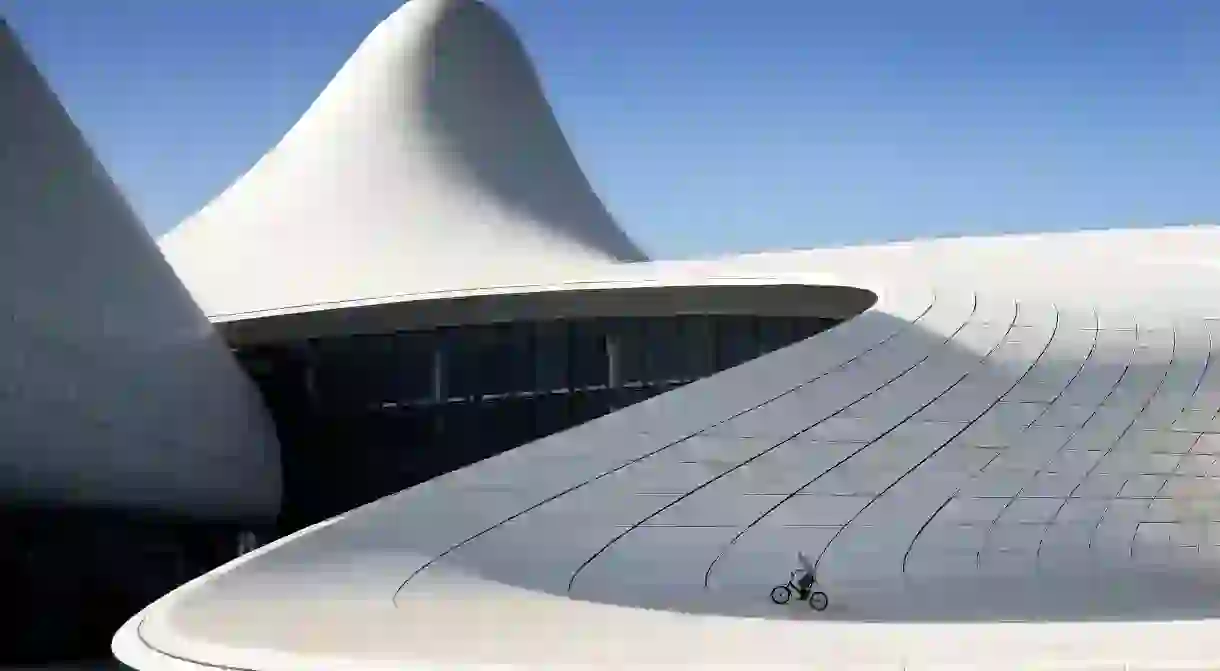Transport in Baku: Getting Around in the Azerbaijani Capital

Getting around Baku is a cinch. While walking will get you to most downtown destinations, public transport will help expand your sightseeing horizons while in the Azerbaijani capital.
Baku’s public transport network offers a convenient, economical and relatively eco-friendly way to explore Azerbaijan’s culturally rich capital. Public transport has a prominent place in the lives of most Bakuvians, who use the metro or public buses every day. In addition to walking, cycling is also becoming increasingly popular among the city’s residents. Whether you choose to walk, bike or take a metro, bus or taxi to your destination, this guide will help you to make the most of your time in Baku.
Walking

If you’re staying downtown, there is no better way to get around most tourist locations than by taking a stroll, especially if the weather is nice (as it often is in Baku, where it rains, on average, only 49 days per year).
Just two centuries ago, nearly the entire population of Baku lived within the walls of the historic Old City, which dates back to at least the 12th century. It is here that visitors will find the majority of the city’s historical attractions. Marked by a tumultuous history and a diverse array of dining options, the Old City is a walker’s dream, thanks to the many pedestrian streets that wind through this historic neighbourhood.
Walking anywhere downtown can be easier (and faster) than taking a bus or a taxi, particularly during rush hour. For a pleasant stroll close to the Old City, head to the northern side of its wall, where you will find mansions and other buildings from the oil-boom era of the early-19th century. On the southern side of the Old City is Baku’s longest park, known as the Baku Boulevard. The promenade stretches along the Bay of Baku and is home to restaurants, teahouses, plenty of green space and two shopping malls.
Metro

The metro is another efficient way to get around Baku, especially if you are travelling out to other parts of the city. Baku’s metro system extends to most of its corners, with stops nearly every 2km (1mi).
Among the most-visited tourist locations outside the downtown area is the Heydar Aliyev Centre, an astounding architectural icon that hosts art and design exhibits, including contemporary artworks by the likes of Anish Kapoor and Yayoi Kusama. The nearest metro station is Nariman Narimanov; from there, it takes about 17 minutes on foot to reach the centre. The metro also extends to the regional bus station, where you can hop on a bus with a low-cost ticket to visit the Azerbaijani countryside.

The metro is easy to use once you have familiarised yourself with the different routes and know when to change trains. To enter the metro, you will need a BakıKART – a plastic transportation card, which is sold inside the subway stations or at one of the city’s many kiosks. To upload money to your card, use the cash terminals located at the entrances of the stations, and tap it at the ticket gates for access to the metro. The fare for entry is 0.30 Azerbaijani manats (£0.14). Transfers within the metro system are free.
Bus

Two types of bus lines run through the town, red and blue, covering nearly every part of the city. The bus system is straightforward and easy to navigate.
The city’s red buses are more sophisticated and run on liquid gas, which helps to keep carbon emissions to a minimum. Featuring air conditioning for hot summers and heaters for the winter months, these modern red buses will take you to the city’s most significant locations. There are also designated areas equipped for passengers with disabilities so that they can ride comfortably. You can also use your BakıKART on these buses; tap the card reader at the front of each bus. For only 0.20 manats (£0.10), you can cover a great distance, save money and keep your carbon footprint to a minimum.
The smaller blue buses come in handy when travelling to specific locations outside the city, such as one of the seaside areas, or visiting another cool neighbourhood of Baku where red buses don’t go. The blue bus lines cost the same as the red ones, but they only take cash.
Taxi

Whether you are in a hurry to reach your destination or looking to get to a more remote place not accessible by public transport, a ride-share or taxi might be the most convenient option.
Both Uber and Bolt operate in Baku and provide a reliable and good-value service. One key thing to note, however, is that you will need to pay using cash, as the card payment option is not available in Baku (at the time of writing). A one-manat (£0.50) tip is always appreciated.
If you decide to use a regular taxi service, you will need to negotiate your price in a traditional Bakuvian manner – an inevitable back-and-forth exchange before finally agreeing on a fee. Don’t hesitate to counter-offer with a significant discount. The usual fare for this type of taxi is approximately 1.5 manats (£0.70) per kilometre.
Cycling

Though cycling is becoming more and more popular, there are currently only a limited number of cycling routes in Baku. One of the largest designated biking areas is the western end of Baku Boulevard. Here, you can rent basic but reliable bikes for a reasonable price and explore the newest extension of the promenade, which stretches for several kilometres along the bay. Baku is set to get more bike routes, thanks to an initiative by the city’s governing authority intended to increase cycling in the city.













